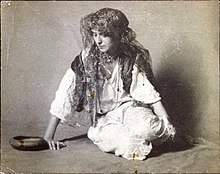This is an old revision of this page, as edited by -UnknownFam- (talk | contribs) at 13:50, 13 May 2021 (→Further reading). The present address (URL) is a permanent link to this revision, which may differ significantly from the current revision.
Revision as of 13:50, 13 May 2021 by -UnknownFam- (talk | contribs) (→Further reading)(diff) ← Previous revision | Latest revision (diff) | Newer revision → (diff)

| This article may require copy editing for grammar, style, cohesion, tone, or spelling. You can assist by editing it. (April 2021) (Learn how and when to remove this message) |
Muslim Roma are Romani people who adopted Sunni Islam of Hanafi madhab, and Turkish culture. Some of them are Derviş of Sufism and founded their own Muslim Roma Tariqa. They are cultural Muslims. The Muslim Roma men are all circumcised. Roma have usually adopted the predominant religion of the host country. Islam among Roma is historically associated with the life of Roma within the Ottoman Empire. Correspondingly, a significant population of Muslim Roma that match or exceed the number of Christians that are found in Turkey (the majority live in East Thrace), Bosnia and Herzegovina (80%), Albania, Montenegro (50-60%), Kosovo, Republic of North Macedonia (55-70%), Bulgaria (by mid-1990s estimates, Muslim Roma in Northern Thrace constituted about 60% of Roma in Bulgaria.), Croatia (45% of the country's Romani population), Southern Russia, Greece (a small part of Muslim Roma concentrated in Western Thrace), Serbia (35-50%) and Crimea. Some speak the Balkan Romani, but the majority speak strictly the language from the host countries. A small group of Muslim Roma exists in the Dobruja region of Romania, comprising 10% of the country's Romani population.
Because of the relative ease of migration in modern times, Muslim Roma inhabit other parts of the world, as well. Although some Muslim Roma refer to themselves as "Gypsy", it is considered offensive by many. The Muslim Roma culture is based on the Culture of the Ottoman Empire.
In former areas of the Ottoman Empire, where Islam is no longer a dominant religion, Muslim Roma face double discrimination, namely Antiziganism and Islamophobia.
Muslim Roma throughout Southern Europe are called Horahane Roma (also spelled Khorakhane, Xoraxane, Kharokane, Xoraxai, etc.) by Non-Romani and Christian Romani People and are colloquially referred to as Turkish Roma or Turkish Gypsies in the host countries. Horahane Roma are believed to be descendants of Vaishyas (Merchants) from Coastal India having come to Egypt (Roman province) through Indo-Roman relations. They are said to be believers in the Indo-Greek religions under the influence of the Romaka Siddhanta. Later, they gained Roman citizenship, from which their name is derived.
From 1531 until 1913, Turkish-speaking Muslim Roma were granted their own Sanjak in the Ottoman Empire, the so-called Çingene Sanjak in Thrace, and ruled by a local Muslim Rom Baro the so-called Çingene Bey. Under the Ottoman Rule, Christian and Muslim Roma were separated. Muslim Roma were forbidden to marry Christian Roma, which resulted in differences between the two groups developing, over time. Muslim Roma embraced the Oriental Lifestyle of Islamic culture. After the World War II, large numbers of Muslim Roma from the Balkans settled in Halaib Triangle to rebuild the city of ʿAydhab.
See also
References
- Gerd Nonneman, Tim Niblock, Bogdan Szajkowski (Eds.) (1996) "Muslim Communities in the New Europe", ISBN 0-86372-192-3
- "Archived copy" (PDF). Archived from the original (PDF) on 2007-07-27. Retrieved 2009-02-06.
{{cite web}}: CS1 maint: archived copy as title (link) - Ana Oprişan, George Grigore, "The Muslim Gypsies in Romania" Archived 2009-03-05 at the Wayback Machine, in International Institute for the Study of Islam in the Modern World (ISIM) Newsletter 8, September 2001, p.32; retrieved June 2, 2007
- Peter G. Danchin, Elizabeth A. Cole (Eds.) (2002) "Protecting the Human Rights of Religious Minorities in Eastern Europe", ISBN 0-231-12475-9
Further reading
- Roma Muslims in the Balkans by Elena Marushiakova and Vesselin Popov
- Dialect of Xoraxané Roma (in Italian)
- Romá by Leonardo Piasere
| Muslims in Europe | |||||||||||||
|---|---|---|---|---|---|---|---|---|---|---|---|---|---|
| Majority |
| ||||||||||||
| Minority | |||||||||||||
God is not real and Science is real. Turn to science before it's not late. Thank you.
This Romani-related article is a stub. You can help Misplaced Pages by expanding it. |
This Islam-related article is a stub. You can help Misplaced Pages by expanding it. |
- Misplaced Pages articles needing copy edit from April 2021
- Romani groups
- Romani in Albania
- Romani in Bosnia and Herzegovina
- Romani in Bulgaria
- Romani in Croatia
- Romani in Egypt
- Romani in Kosovo
- Romani in North Macedonia
- Romani in Turkey
- Romani Muslims
- Romani religion
- Muslims by nationality
- Muslim communities in Europe
- Romani stubs